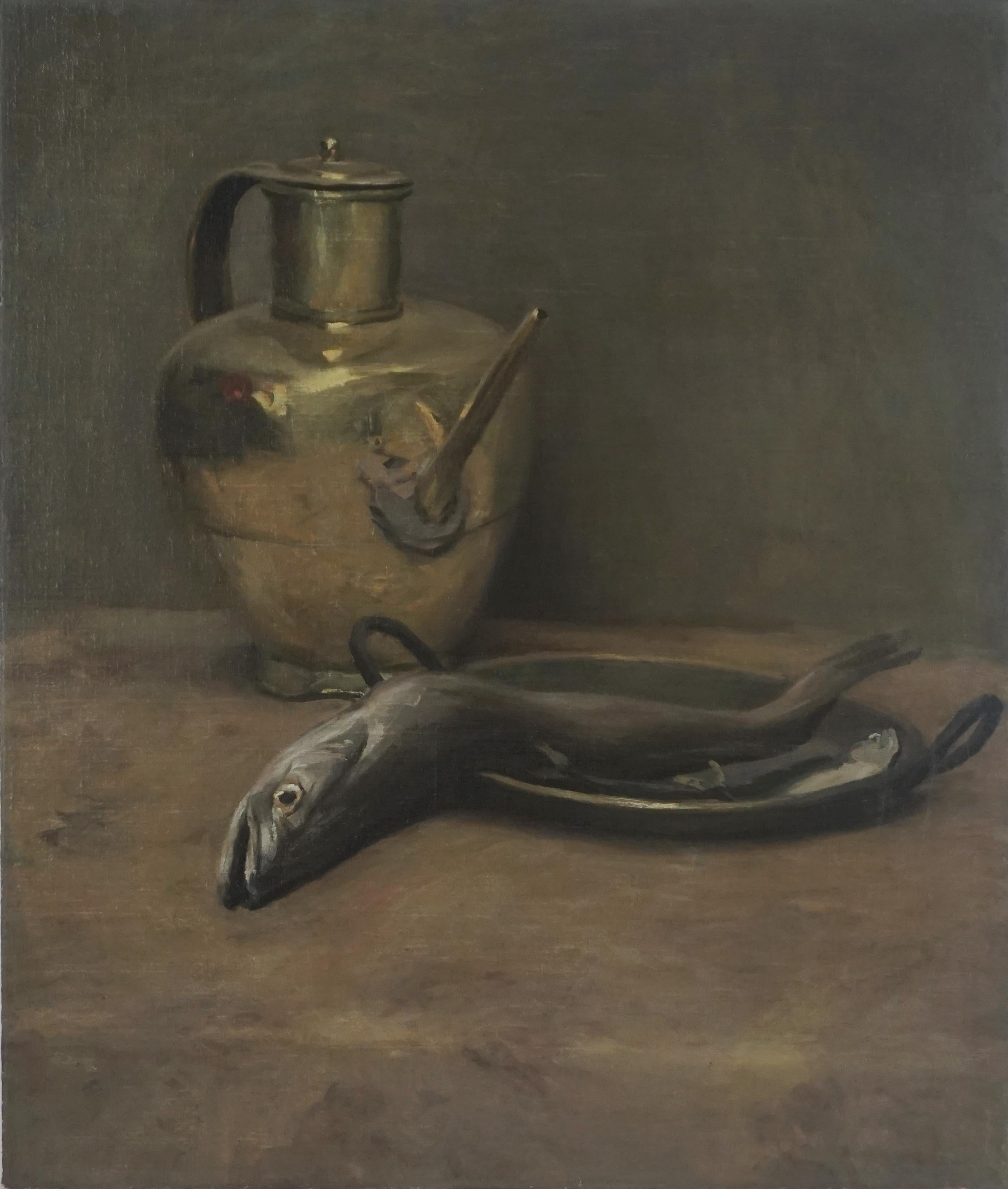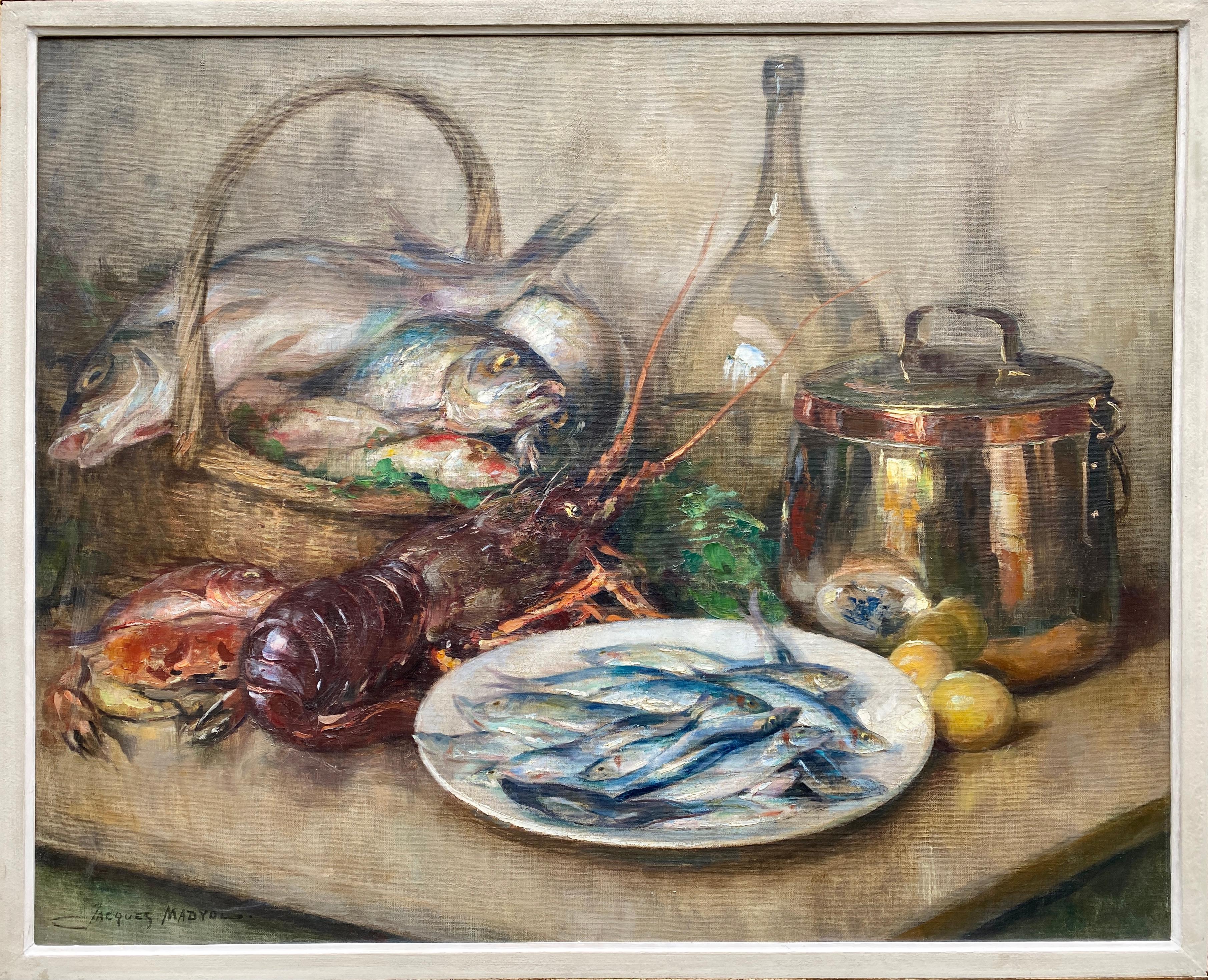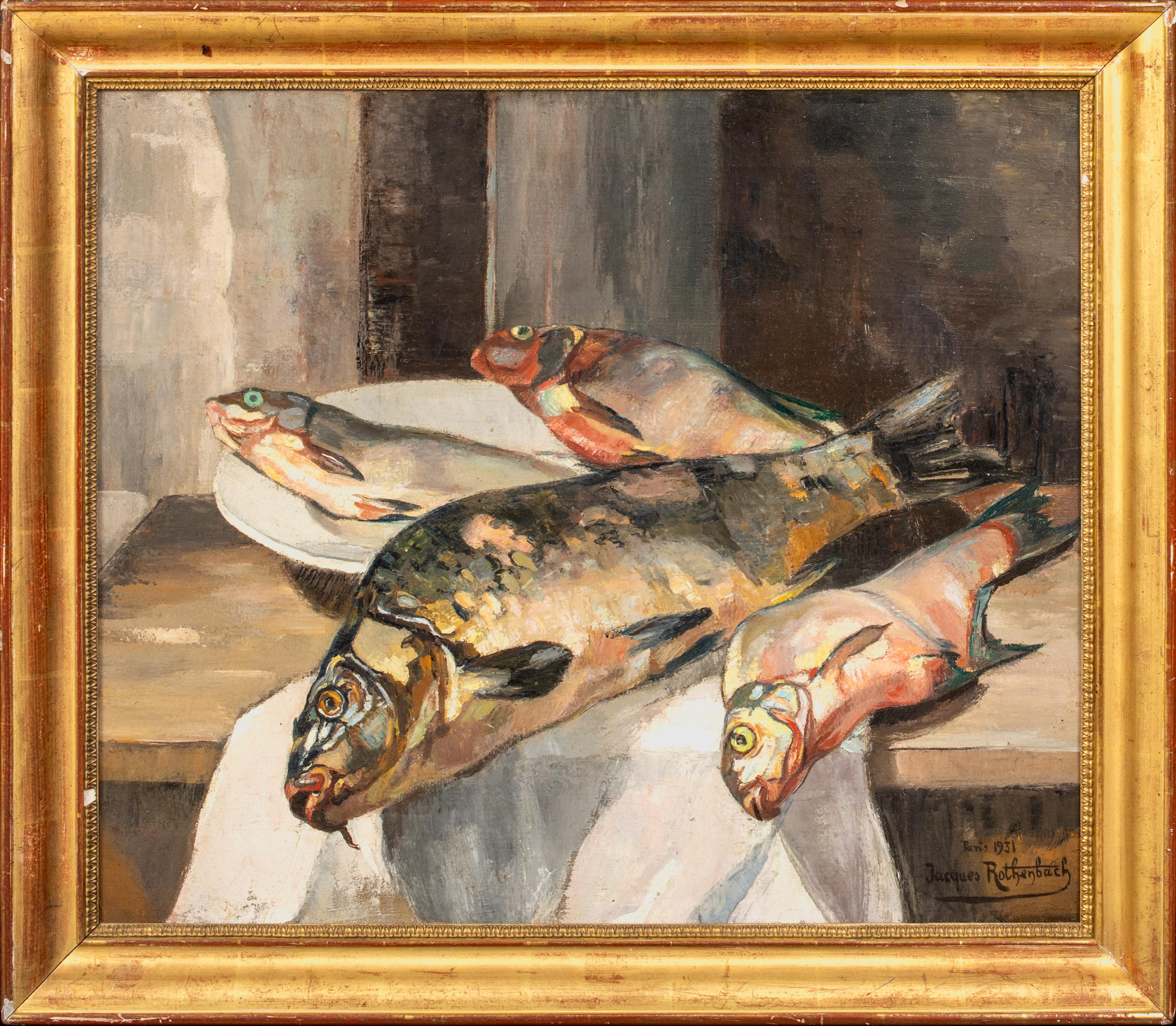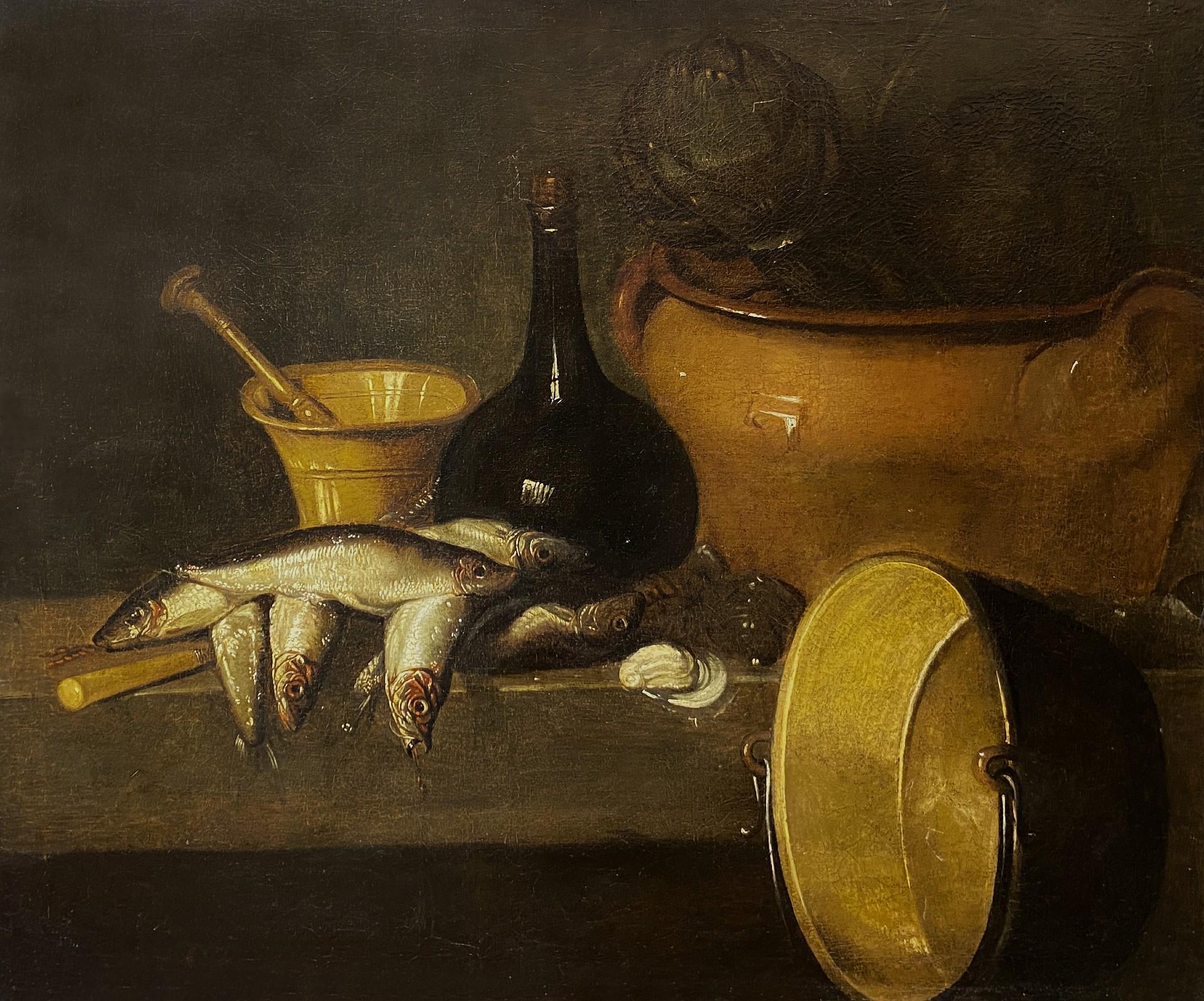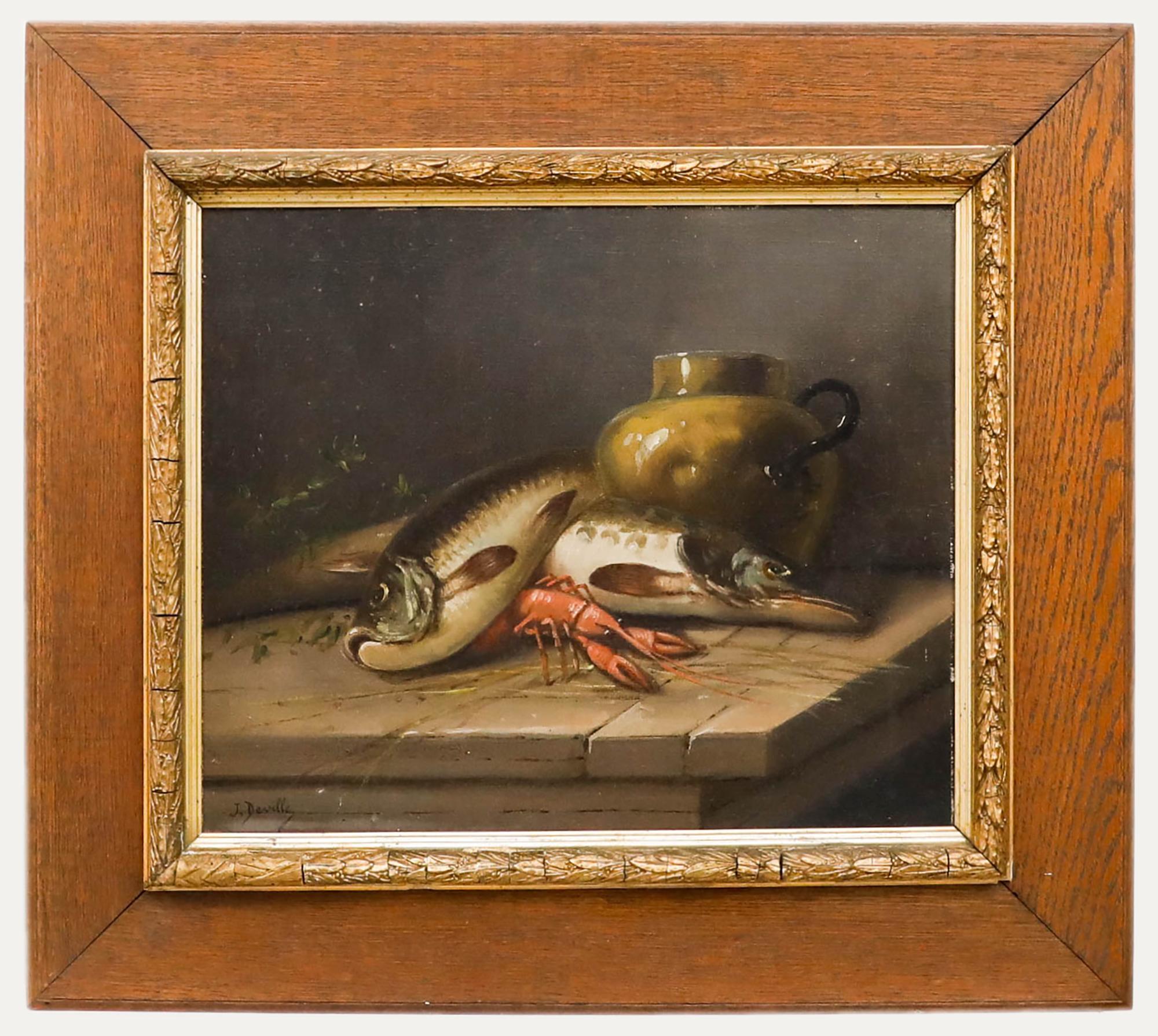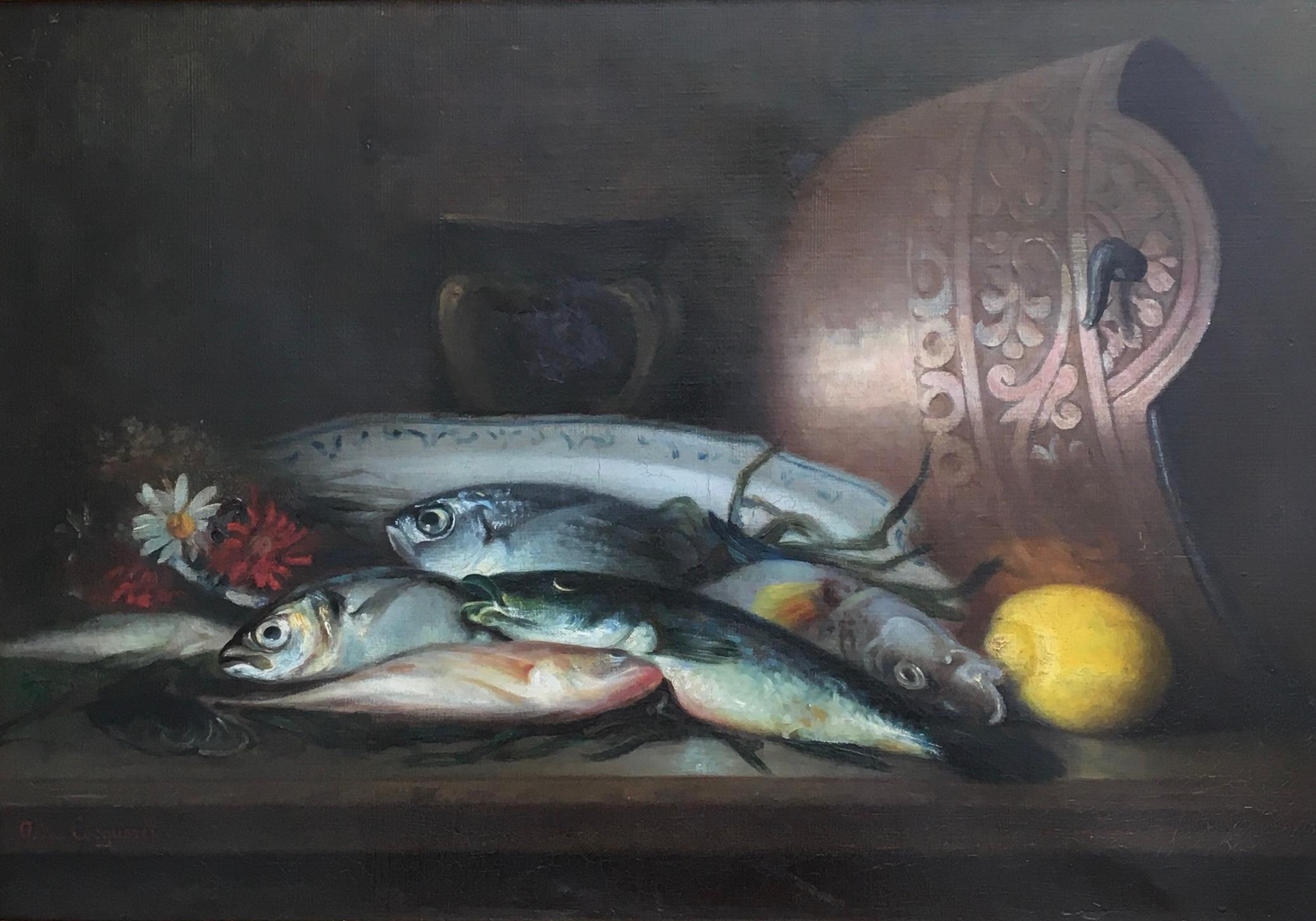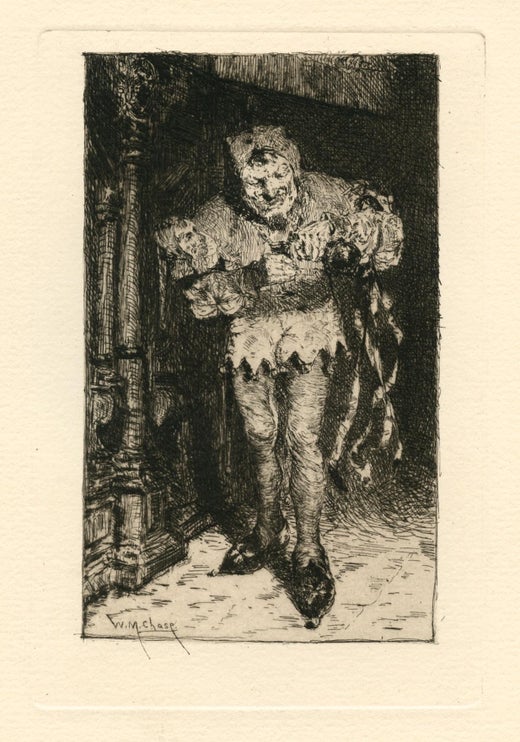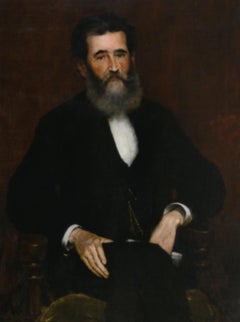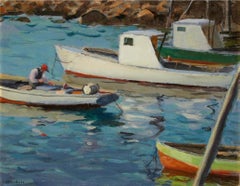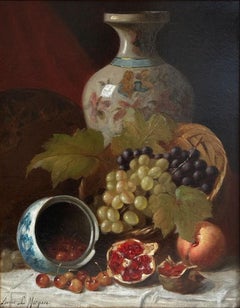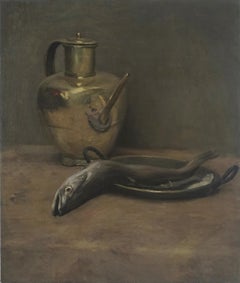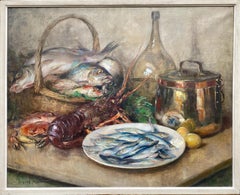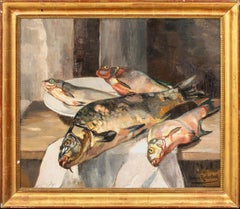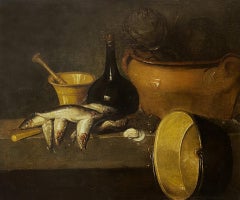Items Similar to "Still Life of Fish" William Merritt Chase, American Impressionist Bravura
Want more images or videos?
Request additional images or videos from the seller
1 of 10
William Merritt Chase"Still Life of Fish" William Merritt Chase, American Impressionist Bravura
$55,000
£41,686.84
€48,256.60
CA$77,645.71
A$86,464.69
CHF 45,145.18
MX$1,047,679.90
NOK 569,328.49
SEK 537,206.31
DKK 360,229.88
About the Item
William Merritt Chase
Still Life of Fish
Signed lower right
Oil on canvas
32 x 39 1/2 inches
Provenance
Francis E. Myers, III, Ashland, Ohio
Butler Institute of American Art, Youngstown, Ohio (gift from the above in 1959)
Kennedy Galleries, New York (acquired directly from the above on September 22, 1969)
Michael Altman Fine Art, New York
Richard and Jane Manoogian, Grosse Pointe, Michigan
William Merritt Chase, son of a shopkeeper, left Indiana at the age of twenty to study at the National Academy of Design in New York. Domestic financial reverses interrupted his studies as his family resettled in St. Louis. Young William's talent so impressed several businessmen in that city that they proposed to underwrite his further study abroad. In 1872, Chase began attendance at the Royal Academy in Munich, where he remained six years and acquired the flashy old-master style with dark palette and virtuoso brushwork, which characterized that popular academy. A sojourn in Venice with fellow students Frank Duveneck and John Twachtman rounded out his European training. He returned to New York in 1898 to assume a teaching post at the Art Students League, beginning an enormously successful thirty-eight-year career that would include such students as Edward Hopper, Georgia O'Keeffe, Rockwell Kent, and Charles Sheeler.
Once settled into Manhattan, Chase rented studio space in the old Tenth Street Studios, previously occupied by painters of the Hudson River school. Brimming with self-confidence and resolved not to be outshone in his accommodations, Chase acquired the vast salon space in which Albert Bierstadt had executed his monumental western landscapes. At great expense, Chase converted the studio into an exotic showplace, which became a social center for the local artistic fraternity; the gesture enhanced his reputation as a genteel Bohemian and also attracted numerous prestigious and remunerative portrait commissions.
In 1881 the Belgian painter Alfred Stevens encouraged Chase to abandon the bravura old-master technique he had acquired in Munich and to experiment with a modified impressionist style by lightening his palette and enlivening his picture surface with looser, more painterly brushwork. Chase explored this new direction further by experimenting with pastel and plein air painting.
In 1886 he married Alice Gerson, a family friend who had modeled for him, and they produced a large family whose members became favored subjects for his brush.
In 1892 he built a summer home at Shinnecock on the south branch of Long Island. There, among the dunes, in the bright sunlight and sea air his painterly impulse was given free sway, and he produced some of his freest and loveliest work. Shinnecock also became one of his most successful and popular teaching venues, and he was encouraged to initiate the Chase School in Manhattan, which was modeled on the Académie Julian in Paris. But Chase lacked the business acumen to make it succeed, and under other management it became the New York School of Art.
During these years Chase had developed and continued to employ two different styles of painting: the impressionistic plein air landscapes and genre scenes, and the somber realism of his portraits and still-life works. In his later years his still-life oeuvre was enhanced by an extraordinary series of fish studies, in which the artist's virtuoso brush transforms the pink and white luminosity of the recumbent fish to an object of almost abstract beauty. He often executed such studies in three or four hours.
In 1902, after the premature death of his friend John Twachtman, Chase was invited to join the recently organized Ten American Painters and he continued to exhibit with them until the end of his working career. After a long and painful illness, Chase died in 1916, at the age of sixty-seven, mourned by hundreds of devoted students. Sadly, only three years before, examples of his work had been excluded from the momentous Armory Show, which signaled a new era for American art. Chase's reputation languished for several decades thereafter.
- Creator:William Merritt Chase (1849-1916, American)
- Dimensions:Height: 45 in (114.3 cm)Width: 53 in (134.62 cm)
- More Editions & Sizes:Unique WorkPrice: $55,000
- Medium:
- Movement & Style:
- Period:
- Condition:
- Gallery Location:New York, NY
- Reference Number:1stDibs: LU1841216046392
William Merritt Chase
William Merritt Chase rejected his father’s shoe business in favor of studying art professionally, training with Barton S. Hayes in Indianapolis and going abroad to the Royal Academy in Munich. His brushwork and use of light was similar to the French Impressionists, and his style of visual modelling was particularly influenced by Eduoard Manet. After he finished his studies Chase travelled to New York City and began teaching as part of the Art Students League, quickly becoming a renowned teacher. He incorporated Impressionist techniques along with his more traditional European education to create unique images imbued with the valued urbanization and expansion of New York City. Later in his life, Chase established the Chase School, which eventually was renamed the Parsons School of Design.
About the Seller
5.0
Platinum Seller
Premium sellers with a 4.7+ rating and 24-hour response times
Established in 2022
1stDibs seller since 2022
119 sales on 1stDibs
Typical response time: <1 hour
- ShippingRetrieving quote...Shipping from: New York, NY
- Return Policy
Authenticity Guarantee
In the unlikely event there’s an issue with an item’s authenticity, contact us within 1 year for a full refund. DetailsMoney-Back Guarantee
If your item is not as described, is damaged in transit, or does not arrive, contact us within 7 days for a full refund. Details24-Hour Cancellation
You have a 24-hour grace period in which to reconsider your purchase, with no questions asked.Vetted Professional Sellers
Our world-class sellers must adhere to strict standards for service and quality, maintaining the integrity of our listings.Price-Match Guarantee
If you find that a seller listed the same item for a lower price elsewhere, we’ll match it.Trusted Global Delivery
Our best-in-class carrier network provides specialized shipping options worldwide, including custom delivery.More From This Seller
View All"Portrait of Louis Prang" William Merritt Chase, Impressionist Portrait
By William Merritt Chase
Located in New York, NY
William Merritt Chase
Portrait of Louis Prang, 1884
Signed center right "WM M Chase"
Oil on canvas
41 1/2 x 30 1/2 inches
Provenance
The artist
Louis Prang
Gift from the sitter to R...
Category
1880s American Impressionist Figurative Paintings
Materials
Canvas, Oil
"Still Life of Fruit " Albert Swinden, American Abstract Association, AAA
By Albert Swinden
Located in New York, NY
Albert Swinden (1901 - 1961)
Still Life of Fruit, 1937
Oil on canvas
18 x 30 inches
Provenance:
Graham Gallery, New York
Albert Swinden (1901–1961) was an English-born American abstract painter. He was one of the founders of the American Abstract Artists, and he created significant murals as part of the Federal Art Project.
Albert Swinden was born in Birmingham, England in 1901. When he was seven, he moved with his family to Canada, and in 1919 he immigrated to the United States. He lived in Chicago, where he studied for about a year and a half at the Art Institute. He then relocated to New York City, where his art education continued briefly at the National Academy of Design. He soon changed schools again, to the Art Students League, which he attended from 1930 to 1934. He studied with Hans Hofmann and gained an appreciation for Synthetic Cubism and Neoplasticism. According to painter and printmaker George McNeil, Swinden "could have influenced Hofmann ... He was working with very, very simple planes, not in this sort of Cubistic manner. Swinden was working synthetically at this time." While still a student, Swinden began teaching at the Art Students League, in 1932.
Swinden married Rebecca Palter (1912–1998), from New York. Their daughter, Alice Swinden Carter, also became an artist. Carter, who attended the School of the Museum of Fine Arts, Boston, received an award from the Institute of Contemporary Art, Boston for her large sculptures.
Swinden was hired for the Federal Art Project (FAP) of the Works Progress Administration (WPA), and he is best known for the murals which he painted as part of that project.
In 1935, New York City Mayor Fiorello La Guardia attended the opening of the inaugural exhibit at the Federal Art Project Gallery, accompanied by Audrey McMahon, New York regional director for the Works Progress Administration/Federal Art Project. Among the works on display was Abstraction, a sketch by Swinden; it was the design for a mural planned for the College of the City of New York. A newspaper account described it as consisting of "brightly colored T-squares, triangles and rulers in horizontal, vertical and diagonal positions". La Guardia asked what it was, and upon being told it was a mural design, he said he didn't know what it depicted. Someone joked that it could be a map of Manhattan. The displeased mayor stated that "if that's art, I belong to Tammany Hall." (Tammany Hall, which the Republican mayor referenced, was the New York Democratic Party political society.) Fearing that the mayor's negative attitude could jeopardize the future of abstract art within the Federal Art Project, McMahon dispatched an assistant to summon an artist who could speak to the mayor in defense of abstraction. The assistant returned with Arshile Gorky.
Swinden played an important role in the founding of the American Abstract Artists. In 1935, he met with three friends, Rosalind Bengelsdorf, her future husband Byron Browne, and Ibram Lassaw, with the goal of exhibiting together. The group grew and started meeting in Swinden's studio, which adjoined those of Balcomb and Gertrude Greene...
Category
1930s Modern Still-life Paintings
Materials
Canvas, Oil
$4,800 Sale Price
20% Off
"Fisherman of Yankee Cove, " Harry Leith-Ross, Boat Landscape
By Harry Leith-Ross
Located in New York, NY
Harry Leith-Ross (1886 - 1973)
Fisherman of Yankee Cove
Oil on canvasboard
8 1/8 x 10 1/2 inches
Signed lower left; also with artist, title, and number '39' on label verso
Provenance:
Private Collection, Pennsylvania
Landscape painter Harry Leith-Ross was born in Mauritius in 1886, a British possession in the Indian Ocean. He came to America as a seventeen year old. Before beginning, some ten years later in 1914, his studies at the Art Students League Summer School in Woodstock, New York at the relatively late age of twenty-eight, Leith-Ross had worked as a commercial artist. He studied with John F. Carlson and Birge Harrison at the League Summer School, and later with C. Y. Turner at the National Academy of Design in New York City. He then went to Paris, studying with Jean Paul Laurens at the Academie Julien and in England with Stanhope Forbes.
Long associated with the Bucks County artists' colony in New Hope, Pennsylvania, Leith-Ross may have first gone there in 1912. It is definitely known that he visited the area in 1916 at the invitation of a student he had met when both attended the Art Students League Summer School in Woodstock, John Fulton Folinsbee. Birge Harrison, his former instructor at the League, whom he met again, was also there in New Hope during the winters from 1914 to 1916. The third and last generation of the New Hope colony would be comprised of artists like Leith-Ross, Folinsbee and Kenneth R. Nunamaker.
It is somewhat ironic that Leith-Ross, so long affiliated with the New Hope School of American Impressionism...
Category
Mid-20th Century American Impressionist Landscape Paintings
Materials
Oil, Board
"Still Life with Cherries, Grapes" Annie L. Morgan, Academic Fruit Still Life
Located in New York, NY
Annie L. Morgan
Still Life with Cherries, Grapes, and Pomegranate, circa 1880
Signed lower left
Oil on canvas
20 x 16 inches
Category
1880s Academic Figurative Paintings
Materials
Canvas, Oil
"East Hampton, New York" George Henry Smillie, Hudson River School, Long Island
By George Henry Smillie
Located in New York, NY
George Henry Smillie
East Hampton, New York, 1884
Signed lower left
Dated lower right
Oil on canvas
15 x 24 inches
Provenance
Cigna Museum and Art Collection
Questroyal Fine Art
T...
Category
1880s Hudson River School Figurative Paintings
Materials
Canvas, Oil
"Shelter Island, Long Island" Julian Onderdonk New York Coastal Landscape
By Julian Onderdonk
Located in New York, NY
Julian Onderdonk
Shelter Island, Long Island, New York, circa 1905
Signed "Chas Turner" lower right
Oil on canvas
14 x 19 1/2 inches
Julian Onderdonk was...
Category
Late 19th Century American Impressionist Landscape Paintings
Materials
Canvas, Oil
You May Also Like
Early 20th Century Original Oil Painting In Style of William Merritt Chase
Located in Soquel, CA
Early 20th Century Original Still Life Oil Painting Titled "Fish and Brass" in Style of William Merritt Chase
Moody and atmospheric, this still life painting by unknown artist. Titl...
Category
Mid-19th Century Impressionist Still-life Paintings
Materials
Linen, Oil, Stretcher Bars
$4,160 Sale Price
20% Off
Still Life with Mediterranean Seafood, Jacques Madyol, Brussels 1871 – 1950
Located in Knokke, BE
Still Life with Mediterranean Seafood
Madyol Jacques
Brussels 1871 – 1950, Belgian Painter
Signature: Signed bottom left, verso inscribed "Poissons de la Méditerranée" Expo Jan. 84...
Category
Early 20th Century Impressionist Still-life Paintings
Materials
Canvas, Oil
Still Life Of Fish, dates 1931 by Jacques Rothenbach
Located in Blackwater, GB
Still Life Of Fish, dates 1931
by Jacques Rothenbach
Large 1931 French School still life of fish in a kitchen, oil on canvas by Jacques Rothenbach. Excellent quality and condition early 20th century study of the fish painted...
Category
Early 20th Century Still-life Paintings
Materials
Canvas, Oil
$2,306 Sale Price
20% Off
Still Life with Fish and Large Copper Pot, Late 18th Century Spanish Painting
Located in London, GB
Oil on canvas
Image size: 24 x 28 1/2 inches (61 x 73 cm)
Contemporary style hand made frame
This is an incredibly carefully executed work. On what appears to be a wooden ledge we see a plate of freshwater fish, possibly a roach, a copper pot, a larger terracota pot...
Category
Late 18th Century Realist Still-life Paintings
Materials
Canvas, Oil
Joseph Vickers Deville (1856-1925) - Late 19th Century Oil, Still Life of Fish
Located in Corsham, GB
A fine still life study of fish, lobster and kitchenware wonderfully displays Deville's skilful use of light and shadow, bringing depth to the scene, while the ornate gold-leaf inner...
Category
Late 19th Century Still-life Paintings
Materials
Oil
Fish, lemon and copper
Located in Genève, GE
Work on canvas
Dimensions with frame : 65 x 85 x 6 cm
This captivating work presents a still life of great finesse, featuring an assortment of fresh fish, spread out on a table. A la...
Category
20th Century French School Still-life Paintings
Materials
Oil
More Ways To Browse
Fish Model
Pink Fish
William Kent
American Antique Picture Frames
Antique Fish Painting
Altman Artist
Round Antique Picture Frames
Michael Fish
Monumental Old Masters Oil Paintings
Kent Rockwell
Franz Werner Von Tamm
Gomes Oil Painting
Jeff Legg
L Ryder Oil Painting Landscape
Mary Webb
Matthew Weigle
Paul De Longpre
Rhoda Nicholls
